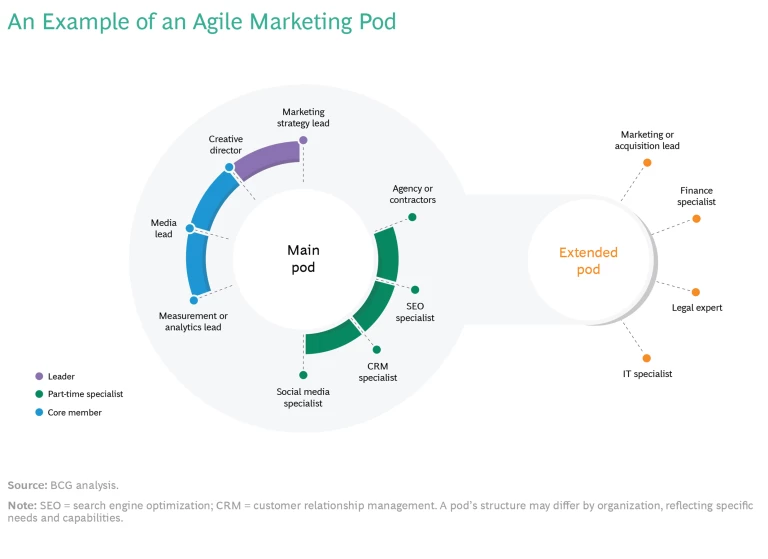When marketers face increased pressure and scrutiny, they can improve quality and increase efficiency by adopting the agile principles that have made product development efforts successful.
The threat of a recession is testing the resilience of marketing organizations, which face growing pressure to prove a return on investment (ROI) as budgets come under scrutiny and potential cost cuts loom. To be resilient, these organizations need to adapt to customer demands sooner, execute better programs quickly, and deliver measurable results faster.
But many won’t pass that resilience test unless they change how they plan, launch, and optimize their campaigns. Traditional internal processes are often too slow, too sequential, and too rigid to launch customized campaigns rapidly and to respond and pivot frequently amidst ever-changing market dynamics. Marketing organizations need efficient, collaborative decision-making processes across multiple functions such as strategy, creative, and media.
In other words, they need to become agile.
In our experience, marketing organizations that embrace agile principles and implement a test-and-learn approach enjoy improved speed to market, higher ROI, and stronger team satisfaction, compared with organizations that don’t.
What Does Agile Mean in Marketing?
Taking an agile approach to marketing means using data and analytics continuously to source promising opportunities or solutions in real time, deploy tests quickly, evaluate the results, and iterate rapidly. It is an organizing principle as well as a mindset. At scale, a high-functioning agile marketing organization can run hundreds of campaigns simultaneously with multiple new ideas on a regular basis.
When a traditional marketing organization tries to accelerate more projects, efficiency and morale typically suffer. Marketers face more competition for their time, which risks stretching people’s attention and resources too thinly. That means campaign launches and other decisions take longer and yield less. Traditional processes also diminish the strategic roles and impact of some teams, such as creative and media execution teams. It turns them into short-order cooks instead of the elite chefs they were hired to be.
Agile pods provide a systematic way for marketing organizations to move fast with frequent touch points, to test new tactics quickly, and to scale successes. A specialty retailer recently used agile pods to deepen its focus on its primary customer segments and expand its new retail media business. These moves combined to increase both the volume and complexity of the marketing organization’s work. It ran campaigns with more creative assets customized to specific customer segments, and it ran a lot of small campaigns that required different creative assets at a time when internal teams were stretched.
Agile pods provide a systematic way to move fast with frequent touch points and to test new tactics quickly.
The retailer’s new focus and expansion would have overwhelmed its existing decision-making processes, which required alignment across multiple internal teams, including strategy and media, as well as external ones, such as media and creative agencies. The roles, responsibilities, and review processes for approvals were not clear. The teams also lacked guidelines about tasks, timing, and handoffs. When team members sensed these vacuums and tried to fill them by taking ownership, they sometimes inadvertently made the process even less efficient by duplicating efforts.
This combination of factors would also have left individual teams frustrated. Media would have thought the creative teams were too slow and unresponsive. Meanwhile, the creative teams would have felt like task takers instead of strategic collaborators because the number of custom requests had increased, even for small campaigns. In addition, although not every campaign needed unique creative assets, the existing processes would have prevented teams from recognizing commonalities across campaigns and reusing or adapting existing content so that they could devote more time to the new and strategically important work.
When the specialty retailer implemented agile marketing pods, it slashed its campaign execution timelines from 25 weeks to under 10 weeks. Better collaboration across teams led to greater efficiency, better morale, and more manageable workloads. Clear priorities gave teams leeway to supplement important campaigns with greater resources and run less important campaigns more efficiently.
The retailer established an agile marketing pod for each of its major customer segments. The roles in each pod include an audience manager (or campaign strategist), a media manager (or media planning and execution lead), a data scientist (or analytics lead), a program manager, and a creative content strategist. A strategic triad—comprising the audience manager, media manager, and creative content strategist—concentrates these core roles to gain early and quick agreement on key issues and fundamental questions. Key issues include the overall strategy for engaging with a specific audience, the messages that will resonate, the necessary creative assets (such as templates or customized assets and how many ad units), and the budget, milestones, and timelines.
The retailer’s agile pods work in two-week sprints, with pod members using daily core-team meetings (or standups) to stay in sync on their progress. Pod members also have an ongoing learning agenda to test new marketing tactics that would allow them to continuously improve their own performance and share successes with other pods. The learning agenda provides strategic direction instead of serving as a rigid roadmap. Each pod holds quarterly ideation sessions to gather hypotheses within those broad guidelines around how it can further improve the efficiency and effectiveness of its media mix, audience targeting, creative, and execution. After assessing the value and feasibility of the hypotheses, each pod designs pilots and integrates the ideas into upcoming campaigns. If a pilot succeeds, the pod will share the tactics and scale quickly. If a pilot fails, the pod will share the lessons among its members and across pods.
Setting Up Agile Marketing Pods
Marketing pods are a variation of the classic cross-functional agile team. The objective is to have people from a variety of disciplines dedicated to the same project at the same time, thus eliminating bottlenecks and making dependencies easier to manage.
Having people from a variety of disciplines dedicated to the same project at the same time eliminates bottlenecks.
Each pod includes three types of members: core members, whose time is fully (or mostly) dedicated to the pod; part-time specialists, who may be members of multiple pods; and leaders, who are responsible for prioritizing the work and connecting with functions or specialists outside the marketing organization. The pod leaders facilitate faster decision-making by bringing specialists into working sessions only on an as-needed basis. (See the exhibit.)
These specialists can belong to a few pods simultaneously, depending on their workload. Mixing and matching provides the marketing organization considerable flexibility. The pod structure, processes, and lessons learned can be scaled quickly to the rest of the marketing organization, once a few pioneering pods have been successful.
Maximizing the Benefits of Marketing Pods
Agile pods are a means to an end, and their efficiency improves when the marketing organization keeps these six guidelines in mind:
- Limit the size of pods. Each pod must be small enough for everyone to remain clearly accountable. This usually means fewer than ten people. But there is no strict formula for the composition or design of a pod. Each marketing organization should design its pods to fit its needs.
- Enable effective communication across and within pods and with other functions. Pod leaders should facilitate cross-pod communication. They should advocate for their pod to get the needed external resources—such as, support from legal and procurement—to accomplish their ambitious goals. And within the pod, leaders should establish clear lines of communication.
- Establish a clear governance structure with simple administrative processes. The marketing organization must define the scope of decisions that a pod can make and lay out specific escalation procedures for decisions that go beyond its purview. Documenting roles, responsibilities, and processes is critical to give pod members clarity on what they are working on, how to communicate internally, and how to make decisions when pivoting.
- Consider agencies as an extension of the marketing pods. Tensions can arise between teams that adopt agile ways of working and teams that don’t. That is a compelling reason to make sure that external agencies can handle the speed of iteration and shorter timelines. Agencies can slow the launch of campaigns if they can’t move in lockstep with internal pods. Marketing organizations shouldn’t take this aspect for granted and should include criteria for agile practices in their requests for proposal.
- Foster a test-and-learn culture with a growth mindset. Marketing pods can have significant impact when they test new tactics and scale the successful ones. The pods should also be able to pivot quickly and embrace changes by viewing them as learning opportunities instead of challenges.
- Evaluate performance frequently. To sustain momentum within the whole marketing organization, it is important to recognize the pods that are doing well. Which pods are achieving better outcomes faster with fewer headaches? Key indicators include hard metrics around marketing performance and ROI as well as soft metrics that show whether the pod members feel engaged and whether they have more time for their most meaningful work.
Winning and retaining customers depends now more than ever on engaging them frequently with personalized messages in the right channels. By aggressively adopting agile practices, marketers can transform their organizations into fast-moving pods that respond rapidly to shifts in customer behavior and continually drive growth.
But organizations face several challenges in making the transition from traditional processes to agile practices. In the next article in this series, we will describe some of these hurdles and offer recommendations for overcoming them.











